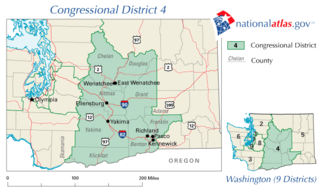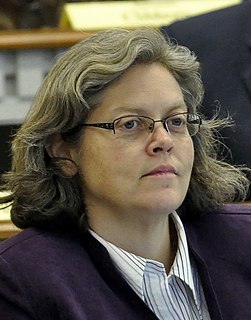
The United States Capitol, often called The Capitol or the Capitol Building, is the meeting place of the United States Congress and the seat of the legislative branch of the U.S. federal government. It is located on Capitol Hill at the eastern end of the National Mall in Washington, D.C. Though no longer at the geographic center of the federal district, the Capitol forms the origin point for the district's street-numbering system and the district's four quadrants.
The Territory of Washington was an organized incorporated territory of the United States that existed from March 2, 1853, until November 11, 1889, when the territory was admitted to the Union as the State of Washington. It was created from the portion of the Oregon Territory north of the lower Columbia River and north of the 46th parallel east of the Columbia. At its largest extent, it also included the entirety of modern Idaho and parts of Montana and Wyoming, before attaining its final boundaries in 1863.
Non-voting members of the United States House of Representatives are representatives of their territory in the House of Representatives, who do not have a right to vote on proposed legislation in the full House but nevertheless have floor privileges and are able to participate in certain other House functions. Non-voting members may vote in a House committee of which they are a member and introduce legislation. There are currently six non-voting members: a delegate representing the District of Columbia, a resident commissioner representing Puerto Rico, as well as one delegate for each of the other four permanently inhabited U.S. territories: American Samoa, Guam, the Northern Mariana Islands and the U.S. Virgin Islands. A seventh delegate, representing the Cherokee Nation, has been formally proposed but not yet seated, while an eighth, representing the Choctaw Nation, is named in a treaty but has neither been proposed nor seated. As with voting members, delegates are elected every two years, while the resident commissioner of Puerto Rico is elected every four years.

The 1976 United States House of Representatives elections were elections for the United States House of Representatives that coincided with Jimmy Carter's election as president. Carter's narrow victory over Gerald Ford had limited coattails, and his Democratic Party gained a net of only one seat from the Republican Party in the House. The result was nevertheless disappointing to the Republicans, who were hoping to win back some of the seats they lost in the wake of the Watergate scandal two years earlier. This election is notable for being the last time any party had a veto-proof majority in the House.
Massachusetts's 1st congressional district is a United States congressional district located in the western and central part of Massachusetts. The state's largest congressional district in area, it covers about one-third of the state and is more rural than the rest. It has the state's highest point, Mount Greylock; the district includes the cities of Springfield, West Springfield, Pittsfield, Holyoke, Agawam, Chicopee and Westfield.

Washington's 4th congressional district encompasses a large area of central Washington, covering the counties of Douglas, Okanogan, Grant, Yakima, Franklin, Benton, and Adams, and part of Walla Walla County. The district is dominated by the Yakima and Tri-Cities areas. The fourth district is predominantly rural, and is considerably more conservative than the western part of the state: it is in fact the most Republican district in the Pacific States.

Massachusetts's 12th congressional district is an obsolete district. It was eliminated as a result of the redistricting cycle after the 1980 Census. Its last location was in south-eastern Massachusetts and its last Congressman was Gerry Studds, who was redistricted into the tenth district.

Washington's 7th congressional district encompasses most of Seattle and Burien, and all of Vashon Island, Lake Forest Park, Edmonds, Shoreline, and Normandy Park. Since 2017, the 7th district has been represented in the U.S. House of Representatives by Democrat Pramila Jayapal.

Washington's 5th congressional district encompasses the Eastern Washington counties of Ferry, Stevens, Pend Oreille, Lincoln, Spokane, Whitman, Walla Walla, Columbia, Garfield, and Asotin. It is centered on Spokane, the state's second largest city.

Elections in Washington are authorized by Articles II, III, and IV of the Washington State Constitution, which respectively include the establishment of elections for the legislative, executive, and judiciary branches of the state government; Article VI establishes election procedures and rights.

The United States House of Representatives, usually referred to as the House, is the lower chamber of the United States Congress, with the Senate being the upper chamber. Together they compose the national bicameral legislature of the United States.

The 1792 United States elections elected the members of the 3rd United States Congress. Congress was broadly divided between a Pro-Administration faction supporting the policies of George Washington's administration and an Anti-Administration faction opposed to those policies. Due to this, the Federalist Party and the Democratic-Republican Party were starting to emerge as the distinct political parties of the First Party System. In this election, the Pro-Administration faction maintained control of the Senate, but lost its majority in the House.
The 1794 United States elections occurred in the middle of President George Washington's second term. Members of the 4th United States Congress were chosen in this election. Tennessee was admitted as a state during the 4th Congress. The election took place at the beginning of the First Party System, with the Democratic-Republican Party and Federalist Party emerging as political parties, succeeding the anti-administration faction and the pro-administration faction.

The 2017 Speaker of the United States House of Representatives election took place on January 3, 2017, on the opening day of the 115th United States Congress, two months after the 2016 elections. This was the 125th speaker of the House of Representatives election since the office was created in 1789. The incumbent speaker, Paul Ryan, received 239 votes, a majority of the votes cast, and was re-elected speaker.

The 2020 Washington House of Representatives elections took place as part of the biennial United States elections on November 3, 2020. Washington state voters elected state representatives in all 98 seats of the House, electing 2 state representatives in each of the 49 Washington state legislative districts. State representatives serve two-year terms in the Washington House of Representatives.











